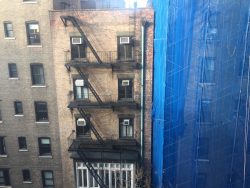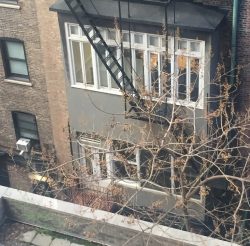Staffer Levi Cohen dwells on dwellings.
It is true that I have gone nearly a full academic year without receiving direct sunlight in my room, thanks to my inauspiciously-placed walk-through double on the dark side of Schapiro. More interestingly, it is also true that I have gone nearly a full academic year staring at several non-Columbia apartment buildings and the people within them. One of them has been covered in scaffolding for some time. Another, shorter building, has beautiful black fire escapes and an A/C unit in each window, and a tree two storeys high that is currently starting to bloom. Below a different building sits a small open space, featuring an assortment of potted plants, plastic chairs, and a small children’s play set.
It’s a unique feature of the urban university that one’s dorm is likely to face a building full of non-university students. You get literal windows into the lives of people who haven’t come to this city to sit in a classroom and talk about Plato, but who rather have families and jobs and probably painful commutes. It’s a little strange and a little wonderful, like a funhouse mirror version of my own living situation. We might all be living vertically, but that’s about it for similarities.
My roommate and I know some of our neighbors by sight now. There’s a girl on a high-up floor that my roommate and I have freaked out about because of how she sits in her window while on the telephone. There’s a family with a young child into whose kitchen we have a straight shot (well, sans scaffolding). There’s a man whose office lights don’t go out until very late at night. All of these people exist. I mean, duh, but still. It’s like that old chestnut about coming to realize that you aren’t the main character in everyone else’s life— staring down a block of apartments, of other lives, basically asks you to contemplate your own peripherality. To these people, you’re the college kid who takes study breaks to thrash-lipsync to Fiona Apple or Courtney Barnett, and you’ll be gone in a few months— that is, if you’re actually anything to them. Maybe you’re just a 2-D part of the landscape, window-dressing (so to speak).
Columbia is among the largest private landowners in New York City. It’s kind of unnerving how many buildings and businesses in this neighborhood have Prezbo & Co. as their landlords. There’s also our northward expansion into Manhattanville, a project that has long been a concern amongst anti-gentrification activists. The question of space, or of space-ownership, is a contentious one in a city as cramped as this. Do these people across from me pay my institution rent? If they do, do they resent it? Do they wish they lived somewhere not as overrun with teenagers?
Most likely, when I’m done living in campus housing and am thrown to the metaphorical wolf that is apartment-hunting in New York, I’ll find myself in a similar situation. Cramped one- or two-bedroom; crappy natural light; view of the neighbors. Another way that Columbia’s prepared me for life after college, I guess. As Corinne Bailey Rae says in “Put Your Records On,” “The more things seem to change, the more they stay the same.”


 1 Comments
1 Comments


1 Comment
@Alum Ah yes, the Schapiro walk-through doubles… no matter what apartment you end up in after graduation, it probably will never be THAT bad again. Also, I liked your interesting observations on what I always thought was a pretty boring courtyard.